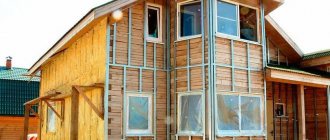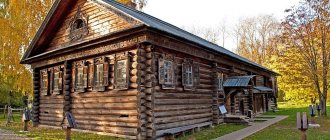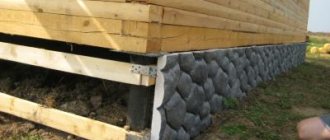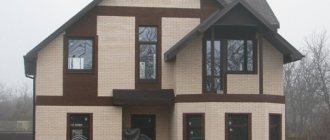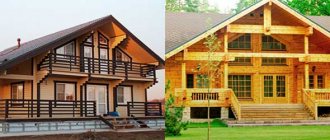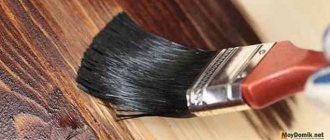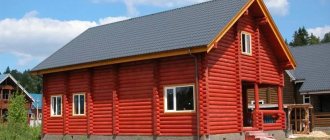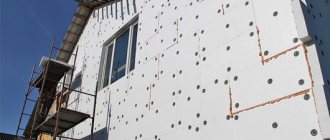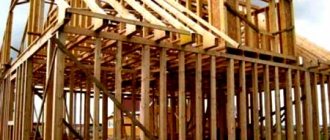High-quality insulation of the foundation on which a wooden house is built will protect the foundation from the harmful effects of freezing, temperature changes, and groundwater.
At the same time, such an event will help reduce the cost of heating the building.
What materials are needed, as well as what method to choose for insulating a strip, column or wooden base - read on.
Features of insulation
Ideally, insulation of the foundation should be done at the stage of its creation. However, even in a built house it is possible to qualitatively insulate the foundation, although the process will be more labor-intensive.
First of all, you need to free the foundation by clearing it to the ground. There should be a trench around the foundation with a width convenient for working in it. If the structure is at the construction stage, then you can use special equipment to speed up the process; if in an already built house, you will have to dig it yourself.
Next, the entire surface of the foundation should be cleaned of dirt, and if necessary, unevenness, cracks, and dents should be eliminated. To obtain a smooth surface, use a concrete or wood grinder. A special solution with a high adhesion speed allows you to get rid of cracks and potholes on concrete foundations. If you use a regular cement-sand mortar instead, you will have to wait about 2 weeks for it to set. It is undesirable to leave the foundation unprotected for such a long period of time.
Before proceeding with insulation, it is necessary to carry out waterproofing. The first step is to apply primer
It is important to achieve unity of coverage so that there are no areas of the foundation unprotected by the primer. It is more convenient to work with a synthetic roller with short pile, in hard-to-reach areas - with a brush
After the primer has dried, roll waterproofing is glued. Fixation is carried out by fusing; there are also more expensive self-adhesive versions of products. Waterproofing should be glued from bottom to top.
Next, the insulation is attached. If these are expanded polystyrene boards, then they are glued (fixation with a bitumen primer on a water-soluble basis is also possible). The slabs are laid end-to-end; try to avoid the formation of gaps between the elements.
The insulation layer located below the ground level only needs to be glued. After filling this part of the base with soil, the insulation will be firmly pressed. It is highly undesirable to use fasteners here, since this means a violation of the waterproofing layer - groundwater will be able to come into contact with the foundation.
The insulation in the above-ground part can and even should be additionally fixed with umbrella-type dowels. A hole of a suitable diameter is first drilled under them, and only then the fasteners are screwed in or driven in.
When using penoplex, a layer of roofing material in the underground part is usually laid on top of it. For the base element, waterproof membranes are usually used, onto which decorative material is then attached (on the sheathing).
The installation of polystyrene foam has already been discussed above. An important point is the preliminary preparation of the sheathing; spraying is usually carried out by professionals.
A completely different installation is typical for expanded clay. To do this, you need to dig a trench and equip it with formwork. Next, a concrete mixture with expanded clay is poured into the space between the latter and the foundation. After this layer has hardened, it can be additionally thermally insulated with expanded clay, and then waterproofed.
If we are talking about insulating a pile foundation with expanded clay, then they act differently. Trenches 30-40 cm deep are dug between the supports, and bars with grooves are attached to the supports themselves. Boards are inserted into them, after which a kind of “pocket” or space is obtained. It is covered with expanded clay.
The process of insulating the foundation is completed by backfilling it, compacting the earth around it, decorating the base or the space between the piles and the ceiling of the first floor.
To learn how to insulate the foundation of a wooden house, see the following video.
Basic methods of thermal insulation of a structure
Consideration of the question of how to insulate the base of a wooden house from the outside should begin with the simplest methods. We will list the main types of work, and you will decide which option is optimal for your conditions.
Backfilling with soil
This method was also used by our ancestors. It is quite simple and unpretentious, earth is poured around the base, and this is where the work ends. It is worth noting that for the best effect, the entire base should be covered, and this does not look very good, especially in combination with modern buildings.
It should be noted that although this technique has almost zero price, its effectiveness also leaves much to be desired. Therefore, this method should not be considered as a solution to the problem. It can only be used as a temporary option.
Insulation using expanded clay
This method was widely used before the advent of modern heat-insulating materials, but is sometimes used now.
Its essence is as follows:
This method allows you to fairly well protect the base from freezing, but it is more suitable for installations below ground level. Therefore, let's consider more practical methods of thermal insulation.
Insulation with foam plastic and extruded polystyrene foam
We can say that this is the most common method of thermal insulation of the base in a wooden house.
This group of materials has a number of advantages:
A disadvantage is the flammability of the material, but modern manufacturers can offer an option with a fire retardant additive; it will be a little more expensive, but its fire resistance is much higher.
Advice! Extruded insulation retains heat better, so its layer can be thinner than that of polystyrene foam. This can be very important in some cases where a too thick base is not desired.
Features of the work:
Recently, extruded polystyrene foam has been increasingly used; it is much more effective than polystyrene foam for a number of reasons:
It is worth noting that when insulating the foundation base with your own hands, this type is more reliable and convenient, but its cost is slightly higher. In any case, you should not save on your own home.
Insulation with mineral and stone wool
This option is also widely used for insulating bases. Mineral wool is a natural material, harmless to health. In addition, this insulation does not burn and is not damaged by rodents, which is also important.
The instructions for installing this type of insulation are no different from the above chapter. All operations are similar to working with foam plastic. The only caveat is that the insulation is much heavier, and more attention should be paid to its fastening.
Polyurethane spraying
The newest method today, which, however, has already collected many of the most positive reviews from developers due to many positive factors:
Advice! Polyurethane foam is especially good on thin, cold foundations due to its high properties; it is also important that it fits perfectly even on the most uneven surfaces.
The disadvantages of the material include the high cost, although if compared with the quality of the material, the price is completely justified. It is also worth noting that it is impossible to apply it yourself - this requires special equipment. Another factor is that the material does not tolerate solar ultraviolet radiation, so it must be covered with some kind of finishing material.
Do-it-yourself insulation of the foundation of a wooden house
The foundation in a wooden house is the main source of heat loss. Firstly, it is in direct contact with the ground, and secondly, it is made of a concrete monolith or slabs that have a high degree of thermal conductivity, which means that heat will escape from the home through it. Insulating the foundation of a wooden house is a necessary and effective means of combating heat loss.
When and how to do it yourself and what materials may be needed? Let's take a closer look. The most optimal moment for insulating the foundation is at the construction stage, when the walls have not yet been erected and there are no rough floors. However, the problem is most often noticed during the operation of the house.
Conclusion
To avoid wasting time and saving money when insulating the foundation, you must first decide what to insulate on the outside. In this case, it is necessary to take into account the climate in the area where the house is located. It is the effectiveness of the material that determines how much of it will be needed and how much the work will cost.
First, they calculate how much heating will cost and decide to install thermal insulation.
Foam plastic is considered one of the cheapest and most effective materials. But it is highly flammable, so fire safety must be ensured. Otherwise, the likelihood of an unpleasant situation is very high.
Polyurethane foam is considered another good insulator, but its price and installation costs are quite high, and you will need special equipment.
There are quite a few options for thermal insulation, so it is worth carefully weighing the advantages and disadvantages of each.
Factors influencing material selection
- soil features on a specific land plot;
- humidity level and air temperature;
- presence of loads.
All these points are important when choosing a material, since we are talking about a wooden structure. To thermally insulate the foundation of such structures, insulation materials specially designed for this purpose can be used. Penoplex slabs are especially popular, due to their ease of installation, high thermal insulation rates and excellent quality.
Polyurethane foam is an ideal option for thermal insulation, both as a fundamental basis and for insulating floors in a private home. Along with its main advantages (minimum weight, low thermal conductivity), the material provides an additional plus - savings. It lies in the fact that during operation the overall costs of insulation are reduced precisely due to its advantageous characteristics. Polyurethane foam is available in various thicknesses. Thirty, fifty, one hundred millimeters are standard insulation values.
In addition to polyurethane foam, simple polystyrene foam has also proven itself well. The low price plus excellent thermal insulation properties made it a worthy candidate for arranging any wooden buildings.
Expanded clay has been used in construction for quite a long time, and to this day it copes well with the functions of insulation. This is perhaps another effective option used for insulation work. Whatever material you prefer, choose it taking into account the design of the wooden structure.
There are several ways to insulate the foundation of a wooden house. Differences in the technology of performing work largely depend on the chosen thermal insulation material.
Differences for different base options
Whatever the foundation under a wooden house, it is necessary to insulate its base and then veneer it. The method of action chosen depends on the condition of the soil under the building, as well as the type of foundation constructed:
- At the strip foundation there is a strip of reinforced concrete located under all load-bearing walls. It is buried in the soil. Insulation is done using several methods: vertical, horizontal or mixed:
- with the first method, the side surfaces of the fill are protected;
in the second case, a blind area is built around it to prevent soil heaving.
- if the climate is not harsh, a mixed type is used.
- With a columnar foundation , the building is well ventilated and there is a minimum humidity level.
However, in winter, the air gap allows the heat to quickly escape, and the soil begins to swell. Such problems can be prevented by insulating the soil around the buried supports, installing a layer of waterproofing on them, and reliably insulating the space under the structure from the penetration of cold air. It is better to carry out such an event simultaneously with the construction of the structure.
The wooden base must be protected in all directions to prevent it from deteriorating due to the aggressive influence of the atmosphere.
Strip foundation
First, they dig a trench all the way to the bottom of the foundation. Its width is 80-100 cm, since the blind area is also insulated at the same time. If the foundation is of a recessed type, then the first 40 cm deep trench is dug to the width of the blind area, and then, to save effort, you can make it 50 cm wide.
If the house was built some time ago, cracks may appear in the concrete. They are covered with a mixture of cement and construction adhesive if the cracks are small. Larger damage is repaired with cement mortar.
The next step is waterproofing. To do this, the surface of the foundation tape is covered with bitumen mastic, onto which roofing material is glued. The sheets are glued overlapping, the seams are additionally coated with mastic. More modern roll materials are also used, such as self-adhesive roll waterproofing.
After this, the insulation is glued. Although penoplex is often attached to dowels, it is still better to give preference to glue or liquid nails - they do not violate the integrity of the sheets. How to insulate a strip foundation with polystyrene foam, watch the video:
The joints between the sheets are foamed with liquid foam.
After installing the insulation, geotextiles are glued onto it. It will reduce the effect of soil heaving on the heat-insulating layer.
Next, the trench is backfilled to the level of the blind area. Sand and small crushed stone are poured under the blind area in a layer of 0.15-0.2 m, and the cushion is thoroughly compacted. This layer will protect the blind area from loads arising from soil movement. A layer of dense insulation is placed on top. The same penoplex is suitable due to its resistance to compression loads. Concrete is poured on top; it can additionally be reinforced with mesh.
Attention! To reduce the effect of frost heaving, the insulation layer is placed at the level of the base of the foundation. The most effective combination of penoplex insulation up to the level of the walls in combination with insulation of the blind area at the level of the sole
Protecting the base floor box from direct contact with the ground
For more effective insulation, it is advisable to completely isolate the foundation box from contact with the soil. When the base is already fully equipped, there is usually a considerable amount of empty space left inside. If it was not initially planned to make a basement in this place, then it would be better to fill it with expanded clay or earth to the floor level. Arranging a cushion of earth is cheaper, especially if it remains after the foundation pit has been dug. However, if there is no free land and it needs to be purchased, then you need to be prepared for the fact that a considerable amount of land will be required.
In this case, it will be more profitable, simple and convenient to make a backfill from expanded clay. With its help, the entire surface of the basement is not completely covered, only half a meter from the foundation strip. This will cost much less than purchasing land for the entire area of the building. In addition, the basement will remain free, which over time can be used as desired.
Thus, you can insulate a wooden house in various ways, it all depends on the type of foundation and design features. In any case, it is necessary to use thermal insulation materials, as they will help provide the entire structure with reliable protection from cold and exposure to external conditions. It must be remembered that despite the strength of concrete, it is quite easily and quickly destroyed under the influence of moisture and cold.
Features of thermal insulation
Before installing an insulation system, the foundation of the building in use must be completely excavated. The surface is cleaned of soil and other contaminants, damage and cracks are eliminated.
Waterproofing layer
It is important to protect the foundation from groundwater. To do this, waterproofing is carried out
Bitumen mastic, special deep penetration solutions, roofing felt, and liquid rubber are used as waterproofing materials.
Installation of insulation
For external thermal protection, foam boards or extruded polystyrene foam are most often used. The insulation is installed using special glue without organic solvents. Additionally, you can secure them using dowels with a wide head. After the glue has completely dried (about two days), the underground part of the foundation is backfilled.
The material is attached to the base in the same way. But in its upper part it is necessary to use non-flammable insulation, for example, mineral wool. So, slabs of expanded polystyrene or polystyrene foam, which are not highly fire resistant, are separated from the wooden structures of the building.
Reinforcement and cladding
A reinforcing mesh is installed on the surface of the insulation, which is embedded in the adhesive solution.
Then you can do the finishing touches. Artificial stone or brick, tiles, and decorative plaster are suitable for this.
Ventilated facades
If fibrous materials are used as insulation, after its installation it is necessary to lay a vapor barrier layer. After that, a sheathing is installed, on top of which the facing material is attached.
Thus, a ventilation gap is formed between the thermal insulation and the finishing, due to which moisture does not accumulate in the insulation and it does not lose its properties.
Is it possible to insulate from the inside?
The recommendations (albums of technical solutions) of leading manufacturers of extruded polystyrene foam contain options for buildings for seasonal residences, which are built mainly in gardens. If the building does not have heating, the base, together with the underground part of the MZLF, is covered with EPS from the inside. Vertical thermal insulation is connected to a horizontal layer of polystyrene foam under the floor along the ground.
Seasonal use (garden house)
The base is covered with a heat insulator from the inside in the only case - if there is no heating in the home at all. The thermal insulation diagram looks like this:
- expanded polystyrene is laid under the floors on the ground;
- fixed externally on the entire vertical surface of the MZLF;
- continues horizontally at the bottom of the trench along the perimeter of the dwelling (width 0.6 - 1.2 m).
Insulation of MZLF during seasonal operation.
An additional layer in the corners is not needed, nor is running along the top edge of the base. Cold bridges are inevitable here; the walls are usually not insulated.
Preparing for home insulation
You can begin insulation only after careful preparation. Firstly, the house needs to allow natural shrinkage. This may take from six months to two years.
If you insulate the house before complete shrinkage, this will lead to bad consequences. The finish will be damaged, cracks will form on it, and cracks may appear at the junctions of the insulation.
Preparing the walls includes inspecting them for defects. In many cases, shrinkage creates cracks that lead to heat leakage; you will have to tinker with them and caulk them.
Treatment of timber with impregnations
The surface of the timber must be treated two or three times with special compounds. Modern antiseptic agents will reliably protect wood from rot, mold, and insects.
The tree also needs to be provided with high-quality fire protection. To increase fire resistance, it is necessary to impregnate it with anti-fungal agents that protect against fire. There are impregnations on the market that simultaneously protect wood from fire, rot, and pests.
Brushes or rollers are suitable for uniform application of medications. After each application of the drug, you need to give it time to absorb well. It is not advisable to process timber under the scorching sun.
Preparing the walls
Before starting work, it is necessary to consider all the irregularities in the corners of the beams, their intersections and other irregularities in the structure itself. Once discovered, you need to get rid of them.
Before you start insulating timber hay from the inside, you need to perform a few simple steps:
- Remove dust;
- Harmful insects can live in the timber; to get rid of them, you need to treat the surface with a special emulsion;
- Wood is a highly flammable material and must be treated with flame retardant impregnations. They will protect the wood from easy ignition;
- There should be no gaps left. If they are, then you need to use caulk. The cracks must be sealed with tow fiber. If there are large gaps, it is better to use tape tow.
Requirements for thermal insulating material for the foundation
Insulation of strip foundations
Any base during the warm season is affected by low temperatures and moisture. To protect it, a suitable insulation is selected, which must have the following properties:
- efficiency;
- resistance to temperature changes ranging from -40 to +30 degrees;
- resistance to moisture;
- durable material structure that can withstand pressure;
- high thermal insulation qualities;
- unattractive to insects and rodents.
The ability of the material to withstand open fire does not matter: since it will be located under the surface of the soil, the possibility of such exposure is minimal. Vapor permeability is not important either.
Making a greenhouse with your own hands from a profile pipe and polycarbonate: a complete description of the process, drawings with dimensions, watering and heating (Photo & Video)
Pile foundation
In order to properly insulate a pile and columnar foundation, it is necessary to perform the following work:
- arrange the basement;
- make internal and external thermal insulation;
- insulate the floor.
The base can be made in two ways:
- Pour a finely damaged foundation approximately 20 cm thick, and then build a concrete or brick foundation on it. Brickwork is made from ceramic bricks or foam blocks.
- Make a metal or wooden sheathing, and then cover the base with siding, clinker panels, metal profiles or other material.
Shallow foundation
This option is the most labor-intensive and also has a number of limitations. It is not recommended to install such a foundation on heaving soils, since in winter cracks may appear on the base, the cause of which is frost heaving of the soil.
It is installed only on soils that are not prone to heaving or in southern regions with a mild climate. Thermal insulation of the base is done from the outside. The insulation material is fixed to a brick or concrete wall using an adhesive composition, similar to as described above.
Insulation of the base over the sheathing
This option can be installed in different climatic zones; it is considered simpler and less expensive.
- First, a frame is assembled from metal profiles or wooden blocks. Usually two to four longitudinal strips are installed, their exact number depends on the height of the base. In some cases, it is also necessary to install vertical slats.
- The wooden frame is attached to the piles using metal embedded parts; the metal profile is simply welded to the pillars.
- The base must be raised above the ground. To do this, leave a gap of 10-15 cm, which is covered with a decorative strip at the finishing stage.
- The insulation is placed on adhesive foam, and for reliability, wooden strips are installed on top, which are attached to the sheathing.
- When insulating, it is necessary to provide ventilation gaps; for this, several holes are made in the finishing around the entire perimeter of the house.
Thermal insulation of a pile-screw foundation can be done:
- polystyrene foam;
- expanded polystyrene;
- foam glass blocks;
- penoizol liquid.
Many, wondering what is the best way to insulate the basement of a house made of timber and logs, settle on the first two options. And this really is the best choice. Foam glass is very expensive, and penoizol requires professional equipment. Therefore, if you do the insulation yourself, it is best to use polystyrene foam or expanded polystyrene for external thermal insulation of the foundation.
Insulation of the base over the sheathing
But you also need to be able to arrange these materials correctly, which is not always possible to do yourself. If insulation is carried out independently, there is always a risk of poor-quality installation. Wood is an unpredictable material, and people who have never worked with wood cannot objectively assess how a wooden structure will behave and when finishing can begin. Therefore, it is better to entrust the insulation of the foundation of a log house to professionals.
has been specializing in working with wooden houses for many years. We carry out finishing and insulation of houses made of timber and logs in the Moscow region. Our masters are highly trained specialists; they all have the necessary qualifications and experience, which they are ready to share with you.
Leave your request on the “Contacts” page, or contact us in a way convenient for you. We will send a specialist free of charge to take measurements and draw up a work estimate.
Calculate the cost of painting and insulating your home right now
Do you have accurate measurements of the house?
I measured it myself. I have a house design. Measurers came. I want to call a measurer.
By clicking on the button, you consent to the processing of personal data
Features of external insulation of a wooden house
Remmers oil - high-quality protection for a wooden house
Features of using Vepost Wood wood sealant
Insulation of a wooden house with Accent 125 sealant
Types of foundations and methods of their thermal insulation
Depending on the method of support on the ground, the following types of foundations used for wooden buildings can be distinguished:
- columnar;
- monolithic;
- tape;
- pile
For the construction of wooden and frame houses, in most cases, shallow foundations are used. They are made of concrete or brick in the form of a strip or slab structure. It is better to insulate such a foundation from the outside. The thermal insulation layer is located at a distance of approximately 1.5 m, behind which a frost-free layer of soil is created.
Columnar base
This type of foundation is constructed from pillars that are dug below the frost line by about 2 m.
The posts are located at all corners and intersection points of the building structure, as well as in places with maximum load.
In this case, the base is made thick and the floors are thoroughly insulated; there is no basement.
Pile structures
When making a screw base, instead of monolithic pillars, piles are used that are screwed into the ground.
It is insulated in the same way as a columnar foundation.
Monolithic foundation
Monolithic is made in the form of a slab under the base of the house; in this case, a basement is not provided.
To equip its buried version, they dig a pit; for a shallow one, the top layer of soil is simply removed. Such a foundation can be insulated with any modern materials only from the outside.
Tape
A strip foundation is created under the walls along the perimeter of the building, provides for a basement, it can be made of concrete blocks.
It can be insulated from the outside and inside without any problems.
Choosing insulation for the foundation
The answer to the question of how to insulate the foundation of a house from the outside is ambiguous. Modern stores offer a wide range of materials. When choosing, they are guided by the type of soil on which the building is erected, the climatic conditions of the region, as well as the degree of load on the structure. There are five insulation products that have an optimal price-quality ratio.
Expanded polystyrene
Expanded polystyrene or polystyrene foam is an inexpensive, practical material. It is widely used for thermal insulation of various structures, including foundations.
Among its advantages are:
- ease of installation;
- light weight;
- excellent thermal insulation qualities;
- foam does not absorb moisture;
- does not shrink during operation;
- does not lose its properties under the aggressive influence of salt or chlorinated water, acids, alkalis;
- it can be used together with mastics, lime, plaster and other materials.
Expanded polystyrene comes in the form of large rectangular sheets. It cuts easily with a regular knife. Therefore, even a novice master can handle its installation.
A significant disadvantage of expanded polystyrene is its low strength. It is damaged even by minor mechanical impacts. Therefore, such material needs additional protection, for example, brick lining.
For heat and moisture insulation of the foundations of houses, it is better to purchase polystyrene foam with a thickness of at least 50 mm. Its average price across the country varies from 2,500 to 3,000 rubles per cubic meter. Service life – up to 40 years.
Extruded polystyrene foam
Extruded polystyrene foam (EPS) is a type of foam. During its production, another technological process is added - extrusion. Thanks to this, the characteristics of the material are improved.
EPPS has the following properties:
- high density;
- complete impermeability to moisture and steam;
- sufficient strength;
- chemical and biological inertness.
- light weight.
To insulate the foundation, a 40 mm thick EPS slab is sufficient. It is mounted using adhesive or disc dowels.
The most popular brands of EPPS are Penoplex and TechnoNIKOL. The cost of a cubic meter of such material varies from 4,500 to 5,000 rubles. The service life, subject to installation technology, is 50 years.
Polyurethane foam
Polyurethane foam (PPU) is a liquid insulation material that is applied to the base using a special sprayer. It hardens quickly, forming a durable coating.
Compared to polystyrene foam and EPS, it has the following advantages:
- when using polyurethane foam, a continuous surface without joints is obtained, which increases the thermal insulation characteristics of the material;
- the product fills cavities and cracks that exist in the concrete foundation, which prevents its destruction;
- easy to apply on complex shaped surfaces;
- has high adhesive properties.
PPU is resistant to aggressive environmental conditions. It can withstand sudden temperature changes, does not deform, and does not release toxic substances into the air.
The price for two canisters of PU foam components weighing 50 kg each on average ranges around 25,000 - 30,000 rubles. With a layer thickness of 5 cm, this is enough to process about 40 square meters of surface. The service life of polyurethane foam is up to 40 years.
Expanded clay
Expanded clay is a material obtained from melted clay. Recently it has been rarely used, since in terms of characteristics it is significantly inferior to polyurethane foam, polyurethane foam and polyethylene foam. Its main advantage is its low price. 1 cubic meter costs about 1,500 rubles.
Expanded clay is distinguished by its environmental friendliness. Since only natural ingredients are used in its production, it does not emit any harmful substances into the air. The service life of such material is more than 50 years.
Its significant disadvantage is fragility. If the technology for manufacturing the insulating layer is violated, the expanded clay granules crumble. This worsens its thermal insulation properties. The downside of expanded clay is also the need for a blind area when laying it.
Mastics
Mastic is a liquid multicomponent composition based on bitumen. More often it is used as a base layer before laying other materials, since its thermal insulation properties are very low.
To achieve a positive result, you need to apply it in three to four layers.
The mastic well fills cracks and voids in the base, which increases the strength of the structure. It reliably protects against moisture.
Why do you need base thermal insulation?
Insulation of the foundation of a wooden house can be internal and external. In any case, thermal insulation will help prevent many of the destructive factors.
External insulation (regardless of material) protects against freezing and cold air entering living rooms, allowing you to save approximately 1/3 of electricity. In addition, the foundation, insulated from the outside, is protected from the destructive effects of moisture from the soil, which extends the life of communications and the very foundation of the building.
Arranging thermal protection from the inside contributes to the formation of an optimal microclimate in the basement and, accordingly, in the house, creates an obstacle to the penetration of groundwater and the accumulation of condensation, which eliminates the appearance of mold.
Technology of insulating a wooden house with polyurethane foam
Unlike expanded polystyrene, mineral wool and other popular insulation materials, the technology of spraying polyurethane foam involves a very complex procedure involving the use of expensive equipment. The thing is that in order for the coating to have the desired characteristics and be resistant to external factors, the mixture of solution components must be supplied under very high pressure.
However, such conditions are fully justified by the fact that the service life of such insulation is from 30 to 50 years. In addition, by choosing this option, you can provide your home not only with heat retention, but also with excellent sound insulation, which no other material used for insulation can boast of.
Another quality of polyurethane foam is its ability to take any shape, which makes it convenient to apply to the relief surfaces of walls and beams.
Polyurethane foam insulation technology
True, it will most likely not be possible to do all the work yourself, since purchasing expensive equipment is more than justified. It is much more rational to invite specialists for this.
Application of polyurethane foam to the external walls of the house is carried out as follows:
- at the agreed time, a team of professionals arrives at your home in a minibus, inside of which there is all the necessary equipment, as well as the components necessary for preparing the mixture;
- hoses are pulled to the places where spraying will be carried out, through which the finished mixture is supplied;
- an even layer of polyurethane foam is applied to the prepared wall surface;
- after hardening, all excess is removed and cleaned.
Like any other insulation, polyurethane foam lends itself perfectly to finishing. Using a reinforcing mesh, you can later apply plaster on top. And if you prepare the frame in advance, it is possible to cover it with siding.
Requirements for insulation
The foundation of a house is regularly exposed to moisture, increased load, and temperature changes. After the onset of frost, the accumulated moisture freezes, destroying the material, and through cracks in the concrete the cold penetrates into the home. As a result, the house always has cold floors, dampness emanates from under the baseboards, and condensation or frost appears on the basement walls (in severe frosts). For thermal insulation to be effective, the insulation must have the following characteristics:
- low thermal conductivity;
- waterproof;
- good mechanical strength;
- resistance to temperature changes.
The material for foundation insulation must meet a number of requirements
There are no strict requirements for the vapor permeability of the material, but insulation materials with low vapor permeability are usually used, just like the concrete foundation itself. The flammability of the material is not of great importance, because the underground part of the building is least susceptible to fire risks.
The photo shows an insulated foundation
Materials
Materials for insulating the foundation of a wooden house must meet the following criteria:
- low thermal conductivity;
- vapor permeability;
- wet strength;
- high wear resistance;
- ease of installation.
The most important characteristics are thermal conductivity, vapor permeability and moisture strength. The less the material conducts heat, the warmer the house will remain. Wood is characterized by the ability to absorb excess moisture and, if necessary, release it
This is why it is so important to use “breathable” insulation materials that can remove excess moisture vapor, preventing them from turning into droplets of water directly on the surface of the walls or insulation. The vapor permeability of the insulation should be close to the vapor permeability of the foundation material; if this is not possible, it is necessary to use a vapor barrier
Among the most popular materials for insulating wooden bases, there are several types.
Expanded polystyrene
This is a well-known polystyrene foam. However, today experts recommend using its best option - extruded polystyrene foam. The latter is characterized by low thermal conductivity, resists moisture better than foam plastic, and has a large margin of safety.
Such insulation disadvantages as environmental unsafety (a certain amount of styrene is released during use) and flammability (depending on the type of product, the material belongs to class G1-G4) when installed on a foundation become insignificant.
The ease of fixation also attracts users - polystyrene foam is produced in the form of rectangular slabs and has a flat surface
For fastening, a special adhesive composition is used (it is important that it does not contain solvents), and umbrella-type dowels are used as additional fastening.
A type of polystyrene foam insulation is penoplex, made on the basis of extruded polystyrene foam. In terms of its performance characteristics, it slightly exceeds the latter, but outwardly it is no different.
Expanded clay
Natural insulation, which is small, air-filled “pebbles”. It is characterized by low thermal conductivity, environmental friendliness, fire safety, good vapor permeability, but absorbs moisture. As you know, wet insulation loses its technical characteristics. High-quality waterproofing can avoid this.
As a rule, expanded clay is used in log houses, as well as houses with ground floors. In this case, a kind of heap is organized - a blind area is made at a height of 50-60 cm from the ground, the walls of which are waterproofed and covered with expanded clay.
Polyurethane foam
Modern insulation with thermal efficiency indicators similar to polystyrene foam materials. In addition, it is moisture-resistant, safe, environmentally friendly, and non-flammable.
Insulation with polyurethane foam involves spraying it over the surface in a layer 3-10 cm thick. Like polystyrene foam, the material is not resistant to ultraviolet radiation, so it is necessary to protect it after setting. In addition, contact finishing cannot be installed in this case, so even before spraying the composition, you should take care of the lathing on which the plinth materials will be fixed according to the principle of a ventilated facade.
Penofol
Rolled material based on foamed polyethylene, which has good thermal insulation characteristics. In addition, one of the sides of the product is equipped with a foil layer, the peculiarity of which is the ability to reflect heat. In other words, the insulation acts on the principle of a thermos - in the cold season it retains heat inside the house, in the summer heat it provides coolness inside the room, preventing it from overheating.
In addition, the presence of a foil coating improves the moisture resistance and strength of the materials. The release form ensures ease of installation.
